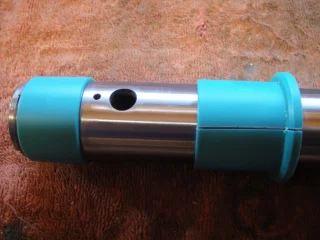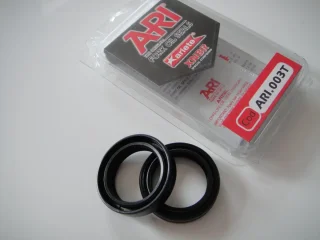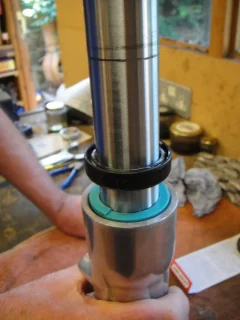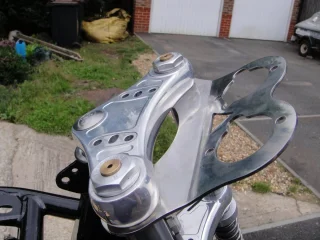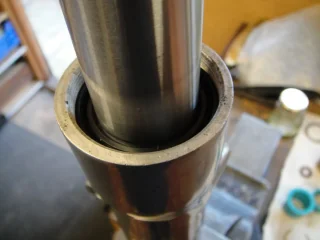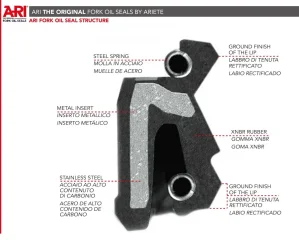Turcite is merely another way to package Teflon in a stronger material matrix for support, since Teflon itself is has very little strength. It is a good material and not at all difficult to machine or design with. I have designed many parts using Turcite as a material and when used properly it is great. It is quite an easy material to process, there are several sections in the link that you provided where they say that Turcite is easily machined. However, it is not suitable for all applications, and that no modern fork manufacturer uses a plain plastic bushing made from that or any other 'modern' material is telling that they are not an optimum solution.
The creation of Turcite from Teflon happens by adding stronger, less slippery materials to Teflon to increase its strength, but this also increases the coefficient of friction when compared to plain Teflon. A DU bushing was designed specifically to present a pure Teflon surface, without those higher friction additives, for minimum sliding friction. Spec sheets for both materials show a DU bushing to have lower coefficient of friction(.02-.12 vs .1-.12), higher load capacity (36ksi vs 12ksi), and higher allowable maximum speed (1000fpm @ 143ksi-fpm vs 100fpm @ 16ksi-fpm) than Turcite material. That is not a surprise and is a result of the DU bushing being a highly engineered assembly designed for a specific purpose: sliding bushings. That mid-80s Suzuki part you used was likely from the first generation of plastics processing technology. I’m sure Teflon bushing production techniques have been improving since the 1980s, which is ancient history as far as plastics processing goes. Turcite is a great general purpose plastic but it has been optimized mostly for use as machine tool way liners, large flat surfaces with extreme loads, not exactly the same type of situation of a motorcycle fork slider bushing.
There are other issues besides coefficient of friction that go into bushing design. Heat conduction is a major, and usually underappreciated, aspect of bushing performance. Plastics (including Teflon and Turcite) have relatively large coefficients of thermal expansion and are poor conductors of heat. With a bushing that is made from solid plastic, these two properties together result in increased bushing temperature and resultant thermal growth which limits overall load capacity and requires larger running clearances for smooth operation. The large thermal expansion of plastic itself requires more initial clearance, the differences in thermal expansion of the bushing compared to the fork tube/slider being similar to running an aluminum piston in a cast iron bore. A DU bearing is designed with bronze and steel lower layers, both of which have small coefficients of thermal expansion and large heat transfer coefficients. This means that the heat from operation is quickly transmitted through the thin outer Teflon sliding surface, through the metal backing, and into the rest of the assembly where it dissipates, thereby keeping the bushing cool and close to its original dimensions, allowing close running tolerances.
One other issue that is not material dependent is the original design of the Norton fork bushings. The extended length of the top bushing is a flaw in the design. Due to the poor metallurgy they had in those days the long bronze bush was required to have enough bushing area under load to prevent compressive failure. However, the longer the bushing length, the more problems that occur when the fork tube bends under load. When under load, the front forks bend slightly. Because of the differences in diameter and wall thickness, the aluminum slider does not bend much when compared to the steel fork tube. As a result, a bent fork tube is trying to slide through a straight bushing/housing. It is easy to visualize that this leads to increased friction/locking up or the requirement to have large running clearances to avoid the friction, both of which are opposite to the needs of a good handling bike. In another post, the image of your top slider bushing with wear marks only near the top is indicative of this, the bent fork tube was only contacting the bushing at extreme points, making the rest of the bushing length unloaded, and thus unneeded.
One benefit to my upper bushing carrier design is that the upper bushing is moved further up the fork tube when compared to the OEM bushing position. This gives slightly increased bushing spacing, which results in lower bushing loads and allows for tighter clearances and better fork performance when nearly topped out.
Another benefit of my kit is that it allows the use of a modern low friction seal with no modifications needed.
>>So most brands go on using the older teflon design bushings that are readily available rather than try something potentially better and deal with the development headaches. It requires out of the box thinking but some new materials do in fact work better than teflon coated/impregnated metal when designed correctly.
It is a little comical that you are saying that every fork manufacturer in the world (including Ohlins, who makes all those MotoGP forks) knowingly chooses an inferior solution to avoid a developmental headache. Have you approached any fork manufacturer with your technology? If it truly is better it would be easily proved.
>> When I saw the metal start to show through the soft teflon I knew it was time to replace them.
Yes, it is a nice built-in visual wear indicator, isn’t it. For other bushings styles you have no idea if the busing is worn out or not. A bushing is by definition a wear item, as are most moving parts of a motorcycle, so it is nice to know when it needs to be replaced.
Chris Cosentino
Cosentino Engineering

